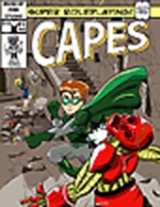
Capes
Encyclopedia
Capes is a role-playing game
by Tony Lower-Basch, independently published
by Muse of Fire Games. It is a superhero
-based role-playing game played in scenes, where players choose what character to play before each new scene. The game is a competitive storytelling game without a GM
. Players create and play the villains who oppose other players' heroes.
Characters are generally co-owned, but controlled by one player at a time. Losers in conflicts can earn "story tokens
" that can be used to influence the game, so it's sometimes beneficial to play a supervillain that gets beaten to get more story tokens.
The game also has a "gloating rule" that emulates situations where (for example) the villain can easily kill the heroes.
Role-playing game
A role-playing game is a game in which players assume the roles of characters in a fictional setting. Players take responsibility for acting out these roles within a narrative, either through literal acting, or through a process of structured decision-making or character development...
by Tony Lower-Basch, independently published
Indie role-playing game
An indie role-playing game is a role-playing game published outside of traditional, "mainstream" means. Varying definitions require that commercial, design, or conceptual elements of the game stay under the control of the creator, or that the game should just be produced outside of a corporate...
by Muse of Fire Games. It is a superhero
Superhero
A superhero is a type of stock character, possessing "extraordinary or superhuman powers", dedicated to protecting the public. Since the debut of the prototypical superhero Superman in 1938, stories of superheroes — ranging from brief episodic adventures to continuing years-long sagas —...
-based role-playing game played in scenes, where players choose what character to play before each new scene. The game is a competitive storytelling game without a GM
Gamemaster
A gamemaster is a person who acts as an organizer, officiant for questions regarding rules, arbitrator, and moderator for a multiplayer game...
. Players create and play the villains who oppose other players' heroes.
Characters are generally co-owned, but controlled by one player at a time. Losers in conflicts can earn "story tokens
Plot point (role-playing games)
Plot point is a term used in role-playing games . It refers to any point given to a player character which can be spent to alter the plot of the game...
" that can be used to influence the game, so it's sometimes beneficial to play a supervillain that gets beaten to get more story tokens.
The game also has a "gloating rule" that emulates situations where (for example) the villain can easily kill the heroes.

